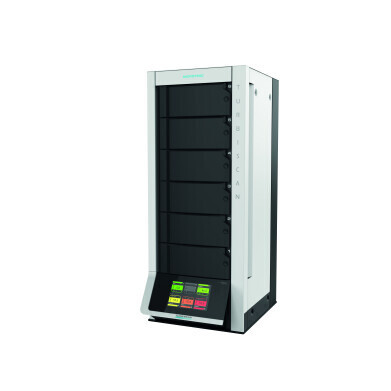-
 TURBISCAN Tower.
TURBISCAN Tower. -
.jpg) TURBISCAN measuring head.
TURBISCAN measuring head. -

-

Laboratory Products
Fast and quantified stability measurement and shelf-life prediction
Mar 06 2024
Formulations and dispersions are heterogeneous systems in a non-thermodynamic equilibrium leading invariably to full phase separation. The TURBISCAN technology from Microtrac Retsch GmbH helps formulators and chemists monitor any evolution of the physical and colloidal stability of emulsions, suspensions, and foams quickly and precisely.
Stability testing: Stop guesswork, and make fast decisions based on facts.
Stability and shelf-life prediction with the TURBISCAN
Formulating is the science of mixing different components to achieve defined properties and quality. Ingredients are often incompatible, and here is where you need science to create stable formulations with consistent and robust structures. The stability of such systems can be from a couple of minutes up to several months to a year. Traditionally, stability estimation is done by visual observation leading to long and tedious tests, not quantitative and highly subjective and operator dependent.
The TURBISCAN technology is the reference method in the stability measurement of such systems for 30 years. Using the TURBISCAN helps you to:
- Save time in your stability measurement
Detection of instabilities is up to 1,000 times faster than visual observation.
- Identify the destabilisation mechanism
Any variations occurring in the sample can be detected and tracked: size variation, aggregation, flocculation, coalescence, migration, sedimentation, creaming, phase separation…
- Quantify with high precision
Based on optical technology, the amount of destabilisation can easily be monitored and used to see the tiniest variation of stability between samples. TURBISCAN can provide migration speed, phase separation kinetic, and size variation evolution as well as the TURBISCAN Stability Index, and single-on click parameter to rank the sample stability.
- Objective measurement
An analytical instrument, no data input, one-click analysis…
- True Stability
The sample is measured as is without any dilution, no sample preparation, and no external forces added. It works on clear and opaque samples, on a large range of particle concentration (from 0.001 up to 95% v/v) and particle size (from 10nm to 1mm).
How it works
High sensitive – non-dilution & non-contact - Light scattering technology:
TURBISCAN works with an optical principle: Static Multiple Light Scattering (SMLS). Photons (NIR light source, 880 nm) are sent into the sample. After these photons have been scattered several times by the particles (or droplets) in the dispersion, they emerge from the sample and are detected by two synchronous detectors. For opaque samples, the backscattering is measured at 135°, for transparent samples the transmission is measured at 0° from the light source. The backscattering and transmission light intensities both depend on particle size and concentration (Mie Theory).
Using both transmission and backscattering allows measurement of the sample as is, without any dilution, and up to 95% particle concentration (v/v).
Precise space resolution
The TUBRISCAN reading head is scanning the measurement vials. Acquisition of the backscattering and transmission are down every 20µm along the entire sample height and scans are repeated in function of time to detect any variation of the sample.
Particle diameter evolution (aggregation, flocculation, coalescence) and concentration change (sedimentation, creaming) can easily be detected and monitored.
Thanks to the high sensitivity of the SMLS technology and by repeating scans, the TURBISCAN delivers unique sensibility to detect & quantify the destabilisation in its very early stage. Thus, giving the ability to quickly compare the stability and predict sample shelf-life.
Application fields
TURBISCAN technology (SMLS) can analyse a very wide variety of samples: opaque or clear, highly concentrated, and very diluted, from nanoparticles to large flocs (mm), emulsions, suspension, colloids, foam… The application field of the TURBISCAN is limitless.
TURBISCAN is used today in research and development and quality control for academic research and in various industries such as:
- Pharmaceuticals: injectables, parenteral, vaccines, drug delivery systems, skin treatments, inhalers, ophthalmic suspension…
- Chemistry: surfactants, stabilisers, polymers and biopolymers, fillers and pigments, latexes, solvents…
- Cosmetics: creams & lotions, moisturisers, sunscreens, detergents, fragranced formulations, cleansers, foundations, makeup…
- Food and beverages: soft drinks, flavour emulsions, beverages, milk, and dairy products, vegetable drinks, plant protein, wine & beers, additives, gums, and stabilisers…
- Paints and Coatings: water-based, solvent-based, resins, varnishes, inks, primers, protective and special coatings…
- Oil & Lubricant: Water in oil demulsification, enhance oil recovery, drilling fluids, crude oils, fuel & oil additives, metal working fluids, lubricating agents…
- Battery: anode and cathode materials, fuel cells…
- And many more: agrochemicals, building materials, electronic segment, CMP slurries, lubricants,
TURBISCAN – The reference analytical tool for stability measurement and shelf-life prediction for 30 years.
More information online
Digital Edition
ILM 49.5 July
July 2024
Chromatography Articles - Understanding PFAS: Analysis and Implications Mass Spectrometry & Spectroscopy Articles - MS detection of Alzheimer’s blood-based biomarkers LIMS - Essent...
View all digital editions
Events
Jul 28 2024 San Diego, CA USA
Jul 30 2024 Jakarta, Indonesia
Jul 31 2024 Chengdu, China
ACS National Meeting - Fall 2024
Aug 18 2024 Denver, CO, USA
Aug 25 2024 Copenhagen, Denmark
-(1)-(1).jpg)


24_06.jpg)













